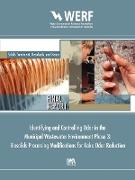- Start
- Identifying and Controlling the Municipal Wastewater Environment Phase 3: Biosolids Processing Modifications for Cake Odor Reduction
Identifying and Controlling the Municipal Wastewater Environment Phase 3: Biosolids Processing Modifications for Cake Odor Reduction
Angebote / Angebote:
Phase 3 of the overall WERF project was developed to study eight Phase 2 hypotheses in more depth, beginning in the laboratory (bench-scale) studies and continuing on to targeted investigations where the WERF team manipulated plant parameters at full scale to identify the best means of reducing biosolids cake odors. The Phase 3 research specifically sought ways to enhance anaerobicly digested and dewatered biosolids to reduce the odor levels in the biosolids end product, thereby reducing negatively perceived impacts on the environment or to the public when beneficially used on land. The goal of the Phase 3 study was to provide a general application of findings to WERF subscribers who are seeking ways to reduce odors produced by anaerobicly-digested biosolids. The Phase 3 options summary presents a general roadmap for wastewater treatment plant operators seeking to optimize biosolids processing and reduce biosolids cake odors. Biosolids cakes with minimal odors lead to better public acceptance near biosolids management sites and in neighborhoods adjacent to WWTPs. Reduced odors also could open the WWTP dewatered biosolids cake to other recycling or disposal opportunities that are currently not used due to odor and other concerns (including on-plant site composting or storage). Additionally, significant cost savings could be realized by not requiring extensive odor control or other expensive options for containment and management of biosolids.
Folgt in ca. 15 Arbeitstagen
